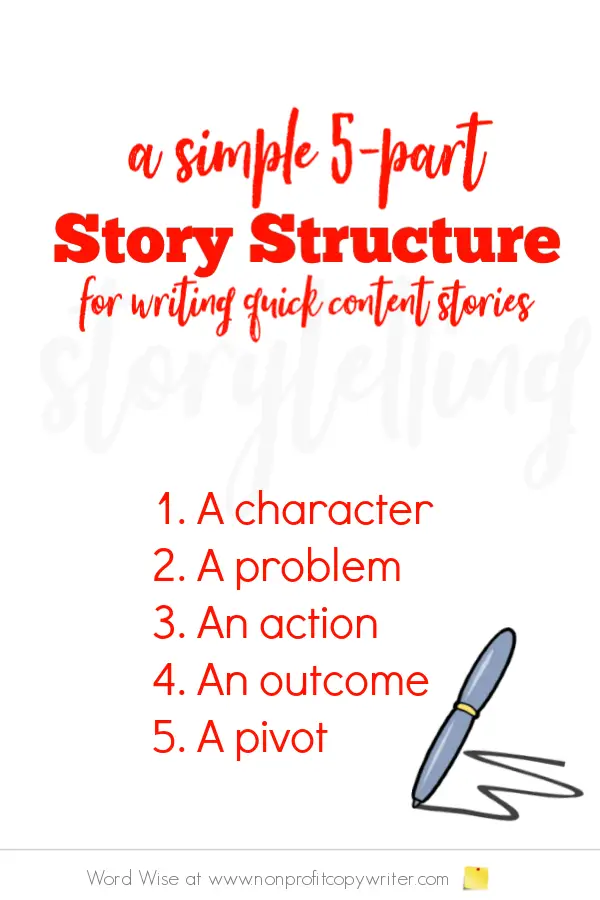Save Time: Get 5 Simple Writing Tips
you can put to use in 10 minutes
Storytelling SOS: A Simple 5-Step Story Structure for Writing Quick Content Stories
Award-winning writer Kathy Widenhouse has helped hundreds of nonprofits and writers produce successful content , with 750K+ views for her writing tutorials. She is the author of 9 books. See more of Kathy’s content here.
Updated 10.14.25
A content writer needs to write persuasive stories.
If the idea of figuring out a story structure makes your fingers quake at your keyboard, then take a breath.
Let me go on the record here to say that when I started writing content, I was intimidated by storytelling.
Yes, I love to read novels. Yes, I realize that interesting characters in a rich setting with multiple conflicts can create a I-can’t-put-it-down book. But for me, the idea of putting all that together is simply overwhelming. (As an aside, thank you to the writers who provide wonderful fiction for me to read! I salute you.)
Then I learned that in order to include stories in my content writing, I didn’t need to write the Great American Novel or even weave a spellbinding tale around the campfire. In content writing, short little stories are quick snapshots that become a hook for article … the centerpiece of a blog post … social proof as part of your grant application narrative.
Meaning all I needed to do was to write quick, itty-bitty anecdotes that illustrate a point and touch a reader’s heart.
A story is made up of a series of events. Story structure is the arrangement of those events to a conclusion. You simply need a formula to follow: a simple story structure blueprint. You can get so good at writing them that you can do so in a sentence or two.
Here’s the simple story structure I use all the time. It works. I hope it will be helpful to you.
A Simple 5-Step Story Structure Blueprint
1. A Character
Introduce the person or group who is the center of the story.
2. A Problem
Stories center around conflict. What kind of situation does this character face? Present the relationship, the challenge, the inner turmoil, the ongoing struggle, the simple irritation, the ambition, or anything in between.
3. An Action
Note that there’s a problem … but there is not always a solution. How does the character act in responding to the problem? Describe the steps that the character takes (or doesn’t take.) The key here is to examine what the character did with her problem. Then you can make your point with …
4. An Outcome
Describe what happened when the character took an action. Was there success, failure, lesson learned, cause and effect?
5. A Pivot
Make a quick connection. How does the story tie to your point? Illustrate a truth? Reinforce your argument? Connect the dots for your reader.
The 5-Step Story Structure Blueprint: An Example
Let’s say you’re writing an article that explains how to complete medical school applications successfully. Here’s an example of a story that could lead off the article or open the section about references.
Anna’s fingers shook as she grasped the envelope and tore it open. “You have been accepted into our medical program,” she read. “We were especially impressed with the experience you have had in working with two of our alumni.” It was then that Anna realized that her references made a difference in her application. What can you learn from Anna? Don’t underestimate …
This little story clocks in at just about 60 words. Boy, that’s quick! Let's see what we've got here.
- Character: Anna. We see that she is nervous.
- Problem: Getting into medical school
- Action: She opened the envelope. But before that, she applied to the school. And before that, she procured references from two doctors. And before that, she worked with those MDs to get experience.
- Outcome: Anna was accepted into the medical school.
- Pivot: What can you learn from Anna? Experience and references make a difference in applications.
It’s not the Great American Novel. But it’s a story that illustrates a point.
And that’s the point, don't you think?
More about Writing Stories for Content
How To Write and Use 3-Sentence Stories ...
12 Places to Look for Story Writing Ideas ...
A Simple 3-Part Story Writing Format for Powerful Content Stories ...
3 Tips for Writing Short Stories that Hook Your Readers ...
Why Telling Stories Sticks, Especially for Readers: It’s Science!
Why You MUST Master Persuasive Storytelling ...
7 Basic Story Plots for Powerful Content Writing ...
Anecdotes: How to Capture Readers with a Slice of Life ...
How to Write a Story to Make a Point ...
3 Story Writing Mistakes to Avoid (If You Want to Make a Point) ...
Story formats to use in nonprofit appeals ...
3 Short Story Writing Tips ...
What is content writing and why do I need it?
More tips on our Writing Stories Pinterest board ...
As an Amazon Associate I earn from qualifying purchases.
Share This Page

Named to 2022 Writer's Digest list
BEST GENRE/NICHE WRITING WEBSITE


Stop Wasting Time!
Grab your exclusive FREE guide, "5 Simple Writing Tips You Can Put to Use in 10 Minutes or Less"












